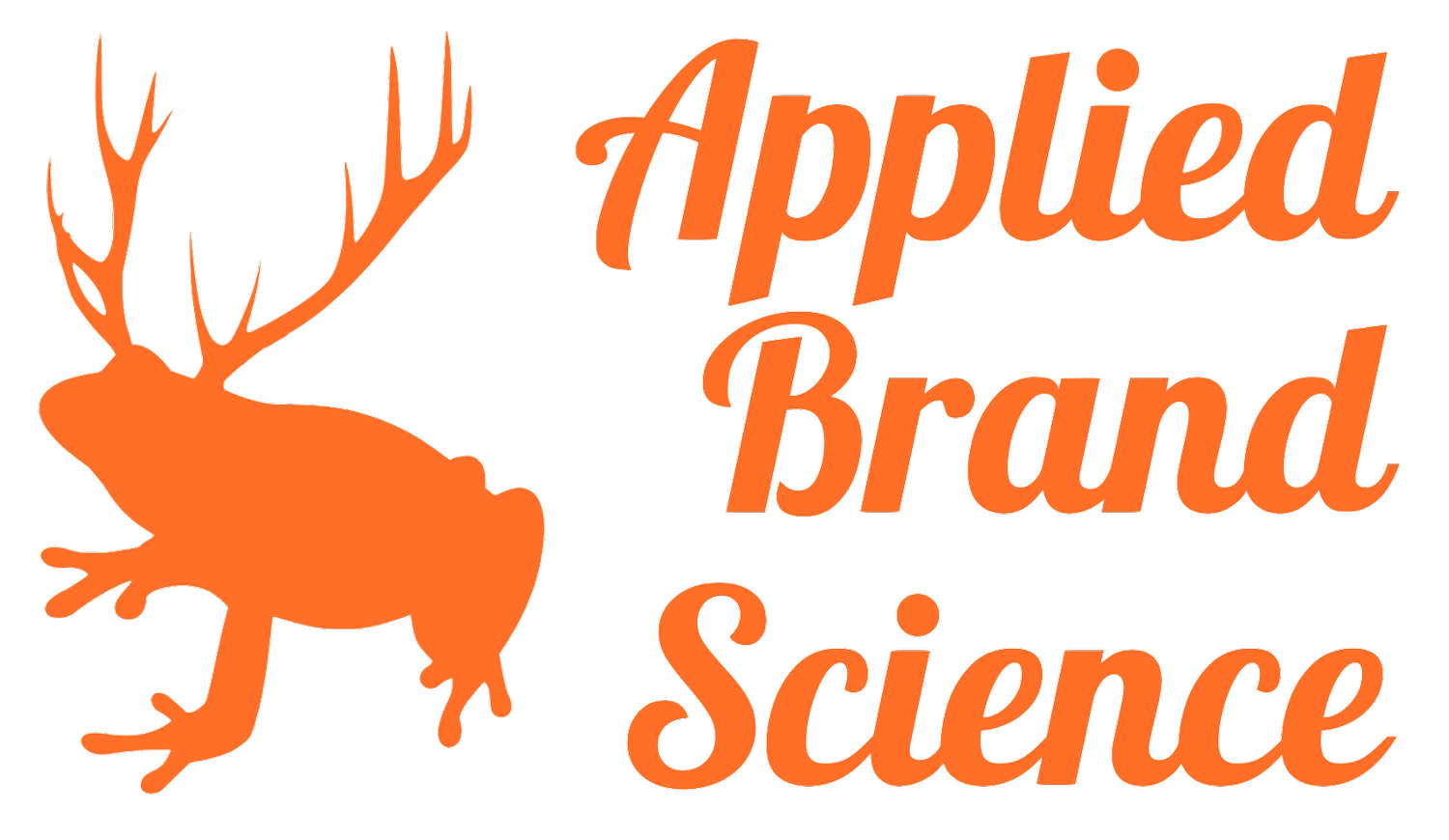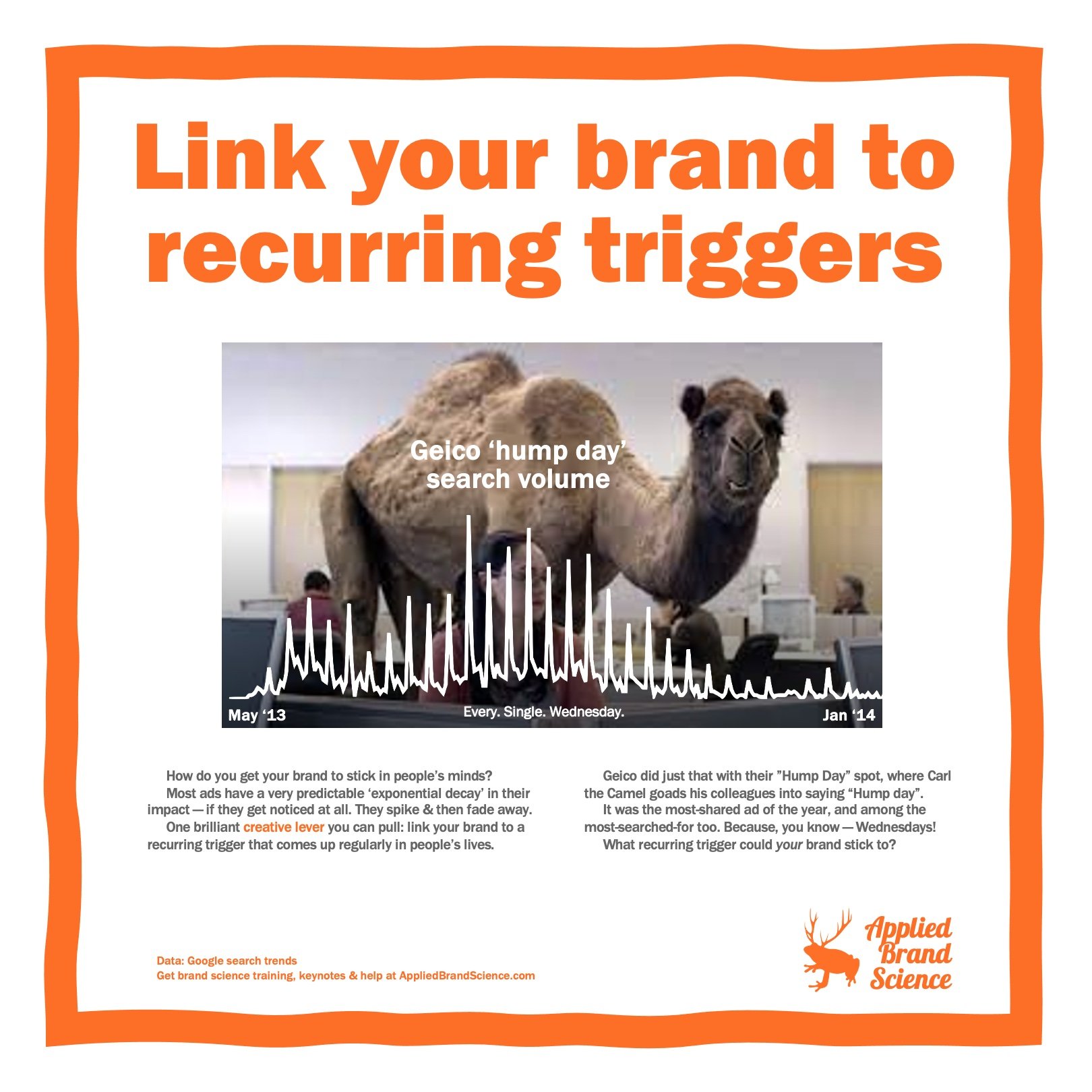
What recurring trigger could your brand stick to?
Most ads have a very predictable ‘exponential decay’ in their impact — if they get noticed at all. They spike & then fade away.
One brilliant thing you can do: link your brand to a RECURRING TRIGGER that comes up regularly in people’s lives.
Geico did just that with their ”Hump Day” spot, where Carl the Camel goads his colleagues into saying “Hump day”.

How much should you fear brand haters?
9% of the time, haters aren’t your biggest issue.
The good folks at @CivicScience surveyed over 27,000 people about their opinions of Dick’s Sporting Goods and R.E.I. (the 2nd and 11th largest sporting goods retailers — in the world).
It turns out, haters are usually dwarfed by the indifferent: people who have no opinion or never heard of you.
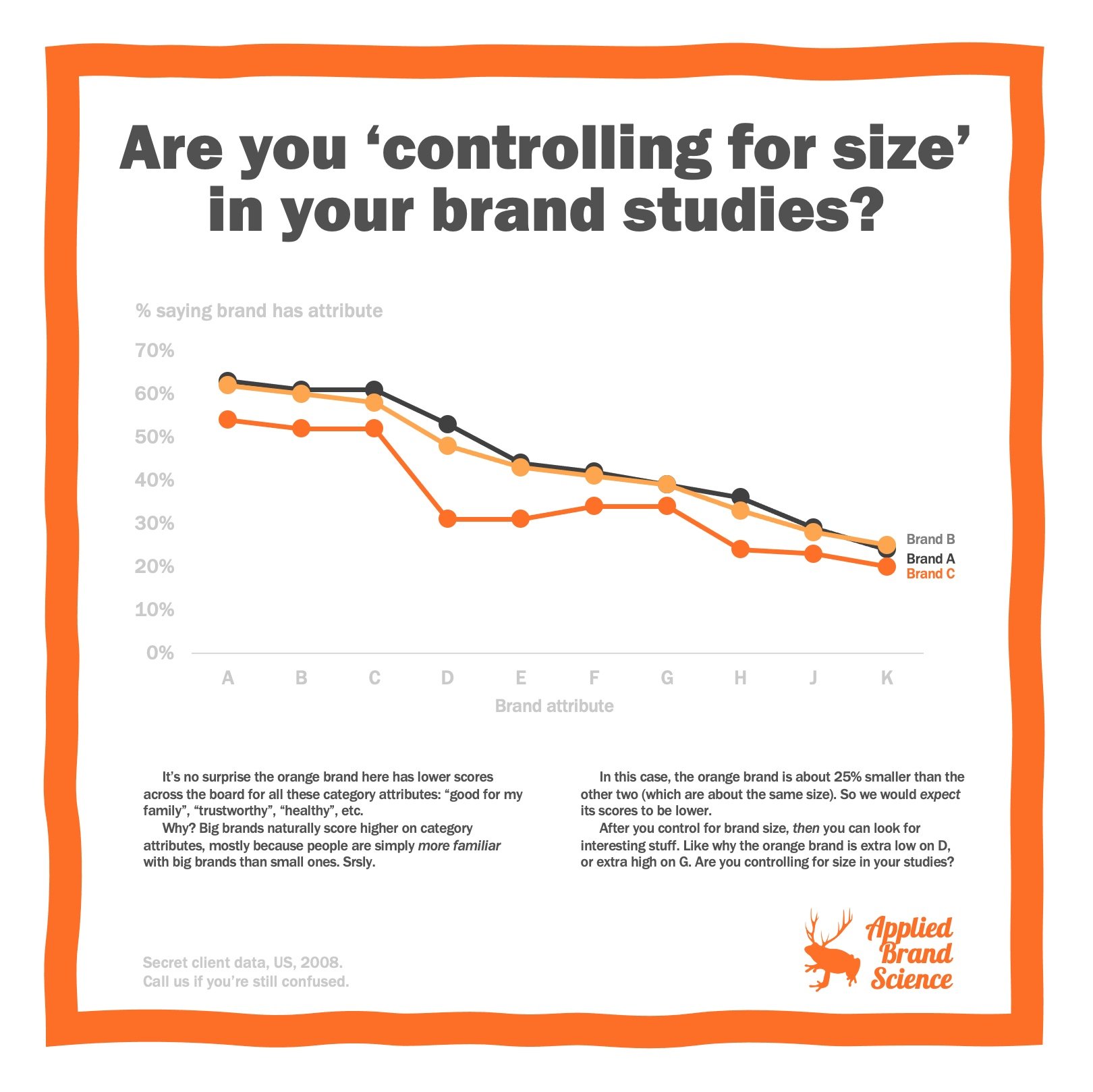
Are you “controlling for size” in your brand studies?
You do a brand tracker or a U&A. You ask people how the brands rate on all the category attributes: “good for my family”, “trustworthy”, “healthy”, etc.
You find out that 2 brands are about tied, and the third brand (in orange here) has lower scores across the board.
Do you freak out and think, “Oh man! Orange is a weak brand!” Nope.
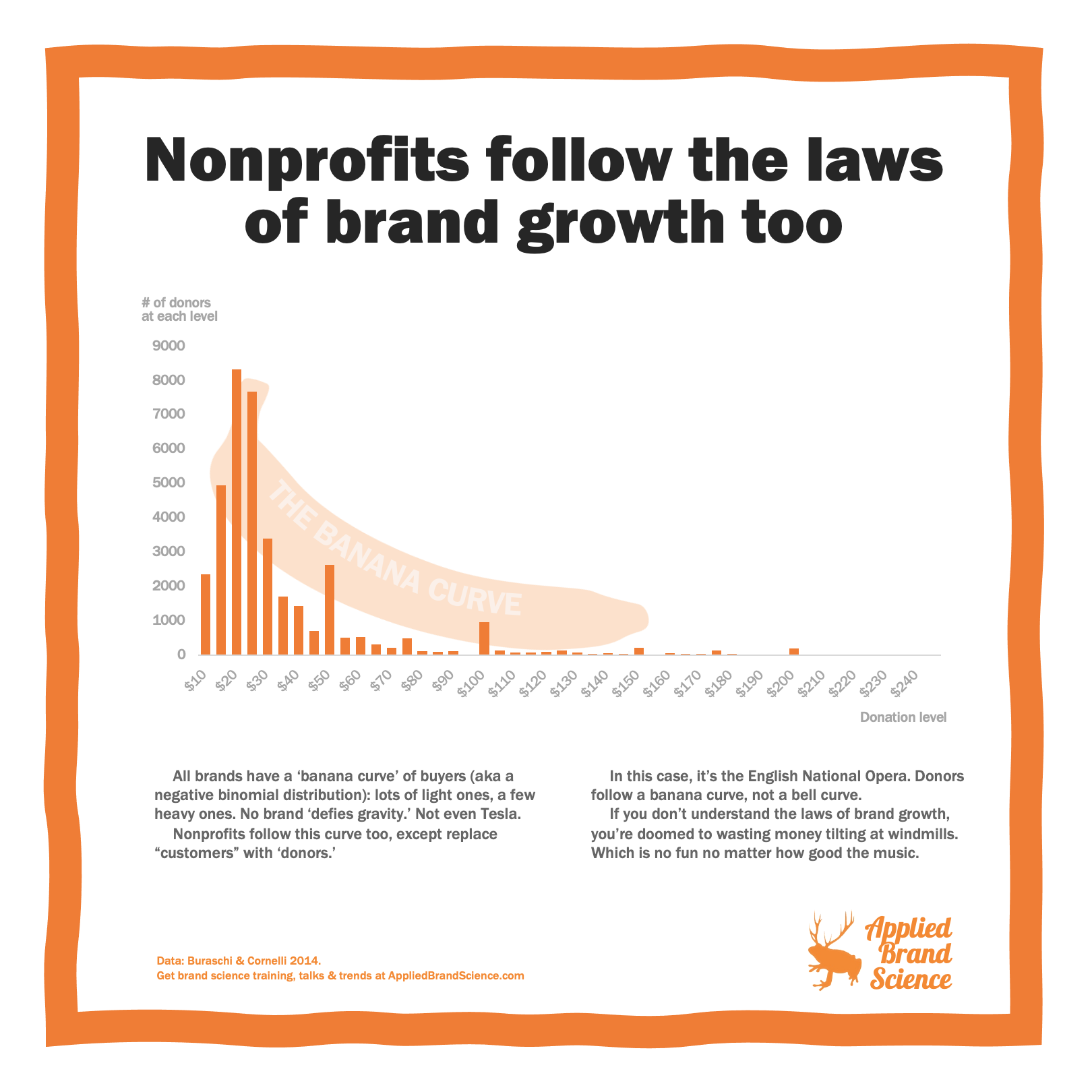
Do nonprofits follow the laws of brand growth?
Does brand science apply to charities and foundations and donors and stuff?
TL;DR: yes.
F’rinstance, all brands have a banana curve of buyers. Not a bell curve. Not a flat line. Not a loyal lump.
Big brands have bigger *ahem* bananas than small ones. But they don’t have a different shape or distribution
Well, if you swap ‘customers’ with ‘donors’, you see the same laws apply to nonprofits.
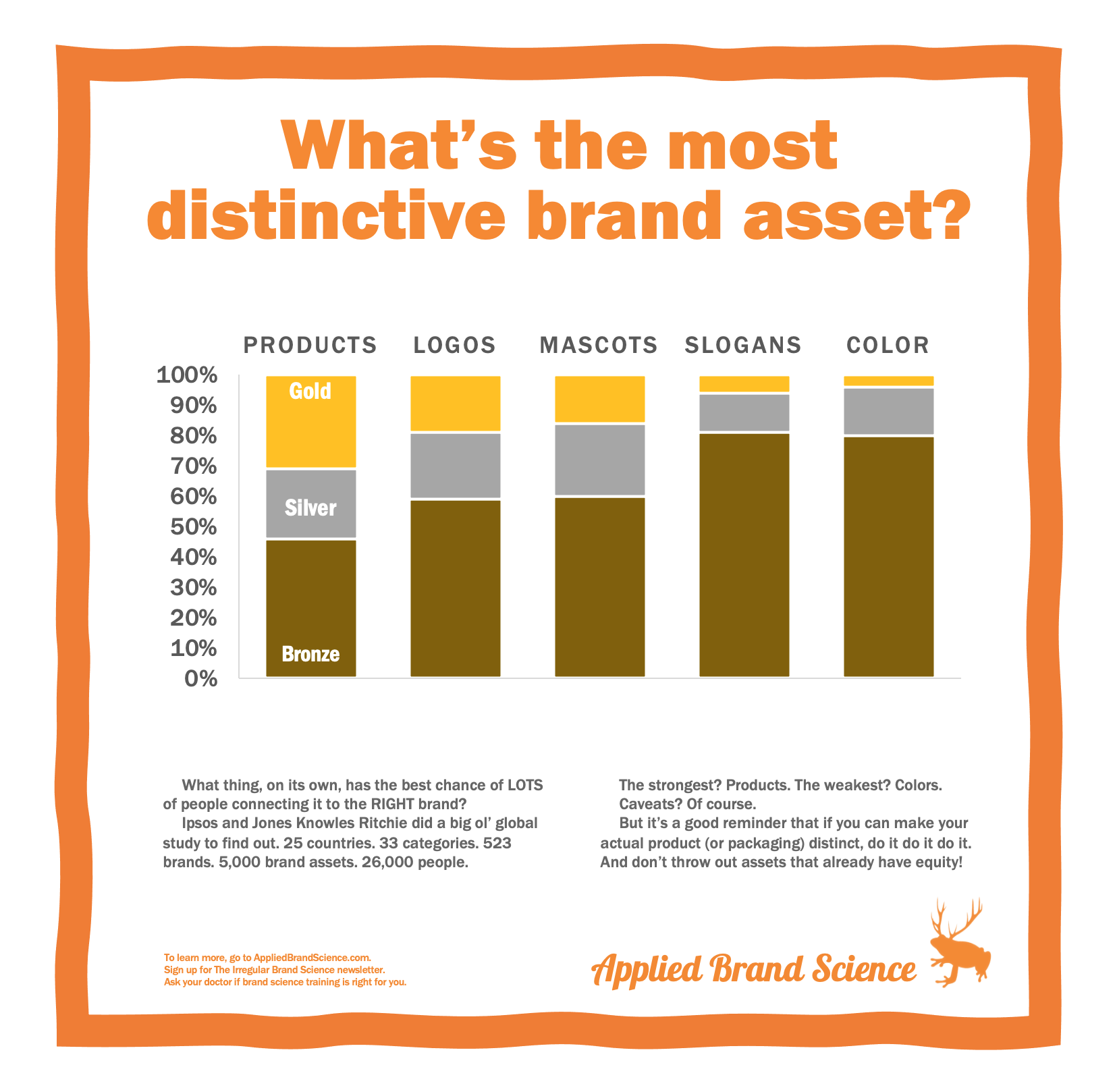
What’s the most distinctive brand asset of all?
Ipsos and Jones Knowles Ritchie did a big ol’ global study to find out. 25 countries. 33 categories. 523 brands. 5,000 brand assets. And 26,000 people.
The core question: did LOTS of people connect the thing to the RIGHT brand?
Then they sliced them into three tiers: gold, silver & bronze.
Is There Brand Loyalty to Colleges?
We usually think of college (or uni) as a loyalty purchase (if we think of it as a purchase at all).
People pick a school, attend it, graduate from it, love it, bleed red & yellow (go Yeomen!), and even send their kids to their alma mater.
And graduation rate is one of our key quality metrics for how good a school is. Start there: end there.
But the data tell a different story.
Are There Any Niche Brands with Crazy Loyalty?
I mean, we hear about it all the time. There’s a pervasive story, a broad belief — dare I say an archetype — of the small, niche brand with the super-loyal customers.
It seems to be extra extra pervasive in the natural foods world. Not sure why. Maybe because health nuts are also supposed to be brand nuts?
But there’s a problem with the story: the data don’t back it up.
Should You ”Bland” Your Brand?
Just to clarify: a logo is not a ‘brand’. Or at least it’s not your BRAND: your ‘Big B’ brand is your entire reputation and the sum total of all you do — product, pricing, where you’re sold, what your CEO Tweets, is it hip on Cape Cod, do you have a store in Monaco, etc.
But a logo is a key, often essential element of your brand. It’s your “little b” brand.
Here are 3 key reasons to keep (or create) a funky logo:
Do Ad Campaigns Suffer Wear-Out?
Like, what if the campaign is still on strategy, still makes sense, but isn’t working as hard as it used to? Or it’s already been a couple years? Does that mean it’s dead?
Four in five of the new campaigns did worse than the effective campaigns they replaced. (That’s 80% for you who don’t like to be ratioed. :-) )
Does 80% of Your Revenue Really Come From 20% of Your Customers?
The latest batch comes from over 330 publicly-traded non-CPG firms, for both product & services, care of scholars Daniel McCarthy at Emory & Russell Winer at NYU.
Do they find an 80/20 pareto ratio of revenue? Not quite.
For non-subscription firms, they find a 68/20 ratio on average. For subscription-type firms, the average is nearly 10% lower, at 59/20.
Is Advertising a “Tax on the Poor”?
Lucky for us, Antenna crunched the numbers for several streaming services that offer both ad-supported and premium ad-free options, including Discovery+, HBO Max, Hulu, Paramount+ and Peacock. The data isn’t exhaustive, and it’s US-only. But their findings were compelling.
From how they see it, there are no significant demographic differences between premium ad-free subscribers and ad-supported ones. Not age, not ethnicity, and not income.
Does GEN-Z Really Prefer Brands With Purpose?
Apparently, when you don’t specifically ask about purpose or CSR, you don’t get Patagonia, Seventh Generation, or Dove.
How Does Market Share Influence Profits?
First of all, share and profit don’t link all the time. They can move quite independently.
But when they do link, ‘market power’ is HALF of the connection. This is primarily the ability to charge a higher price — thus increase profits (natch). But it’s also from getting better prices from suppliers.
Are Premium Brands Only Bought By Affluent People?
Are these differences statistically significant? I dunno, but most likely, yes.
Do these patterns vary by category (cars & stereos & vacations vs shampoo & coffee)? No doubt.
Are there caveats galore? Of course! Sheesh!
But the main findings run against the grain of a lot of “common sense” in marketing, and have real implications for how you market or advertise your products.
Are People Actually Brand "Loyal"?
Bain & Co got some panel purchase data from Kantar in the UK. It covered everything from beer to clothes to hotels to jewellery.
And in every category, most people bought from a “repertoire” of brands over the year or so, not just their favorite. You know: a little Cadbury chocolate, but also some Dove, and maybe some Tony’s too. A Coach clutch,but a Burberry one too.
How Valuable is Your “Brand”?
It’s gotta be more than just your revenue, or your market cap. But how do you measure it? Is it $10M or $10B?
Interbrand just released their latest list of the best global brands. Their formula is “financial performance” + “the role the brand plays in purchase decisions” + “the brand’s competitive strength and its ability to create loyalty.” It’s a secret sauce, but it does meet ISO standards.
BrandZ and Brand Finance have their own methods. Jonathan Knowles was kind enough to gather the data for all three.
Overall, they mostly agree on the ranking of the world’s strongest brands. Whew.
But they disagree quite a bit on the dollar values.
What if we're all a little ageist?
Benny Barak gathered studies from 18 countries around the world on how people feel subjectively (their “felt” age) and what they think is the “ideal” age.
Universally, people FEEL about six years younger than they ARE, and they WISH they were another five years younger than they FEEL.
Why Aren't Old People in Your Ads?
I mean, they’re not in almost any ads, outside the obvious ones for medical devices prescription medication.
Do ads have to completely mirror your audience? Of course not.
But adland is stuck in a curiously ageist loop that could be leaving millions — or billions — on the table.
Big Brands Have Higher Loyalty. Again.
One of the oldest laws in marketing is that small brands suffer twice: they have many fewer buyers, AND those buyers buy slightly less often (lower repeat, AKA loyalty, but don’t say loyalty, it’s a terribly messy word that should only be used for pets & sports teams). This is called Double Jeopardy. It’s older than me.
Is Your Brand Easy to Recognize?
A quick & unscientific way to test is to do an online image search of “your brand” or “your brand + your category”. (E.g., “Starbucks”, or “Starbucks coffee”.) Then zooooom out (Ctrl - or Cmd - ).
Check it on its own & against competitors. Can you tell them apart? Is there anything beyond your logo or product that pops? Do you look like everyone else, or are you creating your own distinct look?

